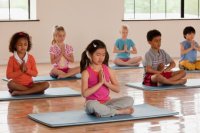Help Students De-Stress for Success
Drug addiction, pregnancy prevention, and eating disorders are all part of the curriculum in the high school health education class I teach. As attention-getting as those topics may be, I like to start the semester by focusing on a health issue that affects almost all teens in high school today: stress.
I've always taught about positive communication, the value of solid friendships, and the importance of preventing depression, but it took me a few years to develop a solid curriculum around stress reduction and relaxation. Over time, however, I've come to think of it as one of the most valuable skills I teach, with a tremendous potential to improve people's lives.
Stress in School
There is a great deal of research showing that unremitting stress leads to increased levels of illness and infection, cuts years off of people's lives, and generally cuts down on people's happiness. If students can learn to deal with stress effectively in high school, and can carry those skills into adulthood, it can have ripple effects throughout their entire lives.
To emphasize just how big a health risk unmanaged stress represents for people, I like to show sections of the National Geographic film "Stress: Portrait of a Killer." (Here's a clip.)
The film focuses on the work of Stanford University's Robert Sapolsky, a neurobiologist who has spent his life studying how stress impacts the brain. He explains how unmitigated stress manifests in the body in both mental and physical ways, causing irritability, insomnia, clogging arteries and increasing the risk of a heart attack.
The film's website features Sapolsky answering questions about why psychological stress triggers the stress response and how using stress reduction techniques may improve a person's health. After hearing what Sapolsky has to say, it would be hard to deny the intense effects stress can induce in people.
How to Address Stress in the Classroom
After showing my students how harmful chronic stress can be, I take some time to teach a few basic stress reduction techniques. A few of my students attended Visitacion Valley Middle School, a school that has a well-established, in-school meditation program, and a few of them have done yoga, but most of them have never done any focused, intentional stress reduction.
When I first introduce this topic, I remind students that everyone's body is different, and that they should try a number of different stress-reduction techniques to see what works best for them. I also remind them that the environment they're in -- a small, crowded classroom surrounded by lots of teenagers -- is a very difficult place to fully relax. I encourage them to try these techniques in the classroom, and then repeat them at home, which may provide a more relaxing place to learn.
I start by asking students about the techniques they already use to relax. Common answers include watching TV, taking a nap, and listening to music. (Sometimes students suggest quiet or instrumental music, but a significant number endorse the stress-reducing qualities of blasting loud, aggressive rock or rap.) We go through other simple suggestions, like laughing with a friend or playing with a pet. And of course, being health class, we talk about how exercise can be a great stress reducer, and how they should make time for physical fitness every day.
We then practice other simple stress-reduction techniques, with the idea that they can learn and practice them in class and then pull them out later when they need them.
Stress-Reduction Techniques for Students
One technique is deep breathing -- simply breathing in slowly for a count of four and out slowly for a count of four. It's amazing how much this simple act of mindfulness can slow things down and create a sense of calm and ease.
We also try visualization. I ask students to think about a place that's relaxing to them, and imagine themselves there. Often people think about a quiet redwood forest or a warm beach, and they can use this technique to transport themselves there any time they feel stressed.
To teach a technique called "progressive relaxation," I ask students to clear off their desk and sit or rest as comfortably as they can in their desks. I dim the classroom lights, and then play a recording from the University of Wisconsin's Health Services office that guides students as they try to relax their bodies from head to toe. It's important to set the tone while introducing the technique, because it's easy for one student to disrupt the whole room with a loud laugh.
Once they give it a try, there are always some students who find it highly effective. In just a few minutes, they look rested and relaxed, and they regularly request that we "do that relaxation thing" again.
Sometimes teaching about positive mental and emotional health is seen as an extravagance or a luxury, but UC-Berkeley's Vicki Zakrzewski argues that it's increasingly clear that teaching young people to manage stress can help them in a multitude of ways. "Simply making a daily effort to cultivate mindfulness and a caring classroom can do wonders for students' emotional well-being," she writes.
With so much clear evidence of the harmful effects of stress, it seems clear to me that stress reduction should be part of every school's curriculum. It's a skill that can really help improve -- and maybe even save -- the lives of our students.
What are some of the ways your school helps students learn to manage stress?
